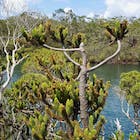
Tree in habitat, riparian/aquatic settings, often with Retrophyllum minus [Adam Black, 2020.02.02, Facebook post].
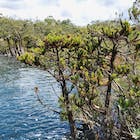
Tree in habitat [Adam Black, 2020.02.02, Facebook post].
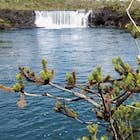
Tree in habitat [Adam Black, 2020.02.02, Facebook post].
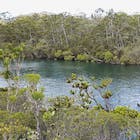
Tree in habitat [Adam Black, 2020.02.02, Facebook post].
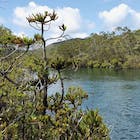
Tree in habitat [Adam Black, 2020.02.02, Facebook post].
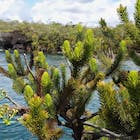
Foliage on tree in habitat [Adam Black, 2020.02.02, Facebook post].
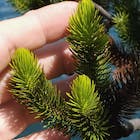
Foliage on tree in habitat Retrophyllum minus [Adam Black, 2020.02.02, Facebook post].

Video on New Caledonia vegetation; D. guillauminii, growing at the Chutes de Madeline, is featured between 24:38 and 26:24 [Crime Pays But Botany Doesn't 2020.02.02].

Conservation Status

Dacrydium guillauminii
Buchholz 1949
Common names
Taxonomic notes
Holotype : Buchhholz 1728 (ILL.) (de Laubenfels 1972).
Dacrydium × suprinii Nimsch 2007 is a natural hybrid between this species and D. araucarioides.
Description
"Small, erect shrub 1-2 m in height. Bark with small dark scales, fibrous, brown inside, at first, covered with many small lenticels, then develops with age many small crevices. Densely branched. Leaves becoming very dense and less spread out with age but not at all reduced in size, sharp, acicular and slightly compressed, imbricate, dense, 13-17 by 1 mm. Pollen cone terminal and lateral, the lateral ones are much smaller at the base below the terminal ones, 8-14 mm long, tapering off from the base. Microsporophylls lanceolate, long, pointed, 5 mm wide at the base of the male cone, 2 mm wide at the apex. Seed cone terminal, sometimes on very short lateral shoots, bracts resemble non-modified leaves, slightly reduced. Seed, up to 5 seeds per cone, subterminal, oval, much larger than thick, with lateral carina, rounded apex with projecting microsporophylls, 4.5 mm long, becoming almost erect, the bracts are exserted which surround the seeds." (de Laubenfels 1972).
Distribution and Ecology
New Caledonia, where it "can only be found within a few kilometers along the river Madeleine (Riviére des Lacs) and along the riverbanks of Lac en Huit in New Caledonia, in which the river flows" (de Laubenfels 1972).
This map shows herbarium records of Dacrydium species native to New Caledonia. Blue is D. araucarioides, green is D. balansae, orange is D. guillauminii, and red is D lycopodioides. Click on an icon for further information. Distribution data from GBIF (2020.03.30), edited to remove duplicates.
The IUCN reports that this taxon is critically endangered,facing an extremely high risk of extinction in the wild. It has an extremely restricted range of less than 100 km2 that is severely fragmented or known to exist at only a single location, and that is suffering a continuing decline in extent and/or quality of habitat and in the number of mature individuals. The total population size numbers fewer than 250 mature individuals and is continuing to decline, with no subpopulation estimated to contain more than 50 mature individuals.
Remarkable Specimens
No data as of 2023.02.21.
Ethnobotany
No data as of 2023.02.21.
Observations
De Laubenfels (1972) reports collections from the following sites:
- Riviére des Lacs (9 collections, 1 specifying elevation of 146 m).
- Lac en Huit (2 collections)
- Plaine des Lacs
- Mine Madeleine
Remarks
The epithet honors professor A. Guillaumin, who assisted Buchholz (1949) with description of this species.
"Dacrydium guillauminii is clearly a very distinct species and one of the rarest conifers in the world. In general morphological terms, it is related to D. beccarii Parlatore from Malaysia and the Solomon Islands" (de Laubenfels 1972).
Citations
Buchholz, J. T. 1949. Additions to the coniferous flora of New Caledonia. Bull. Mus. Natl. Hist. Nat. (Paris), Sér. 2, 21(2):279–286. Available: Biodiversity Heritage Library, accessed 2020.02.10.
Knopf, P., H.Nimsch, and T. Stützel. 2007. Dacrydium × suprinii, sp. nova – a natural hybrid of Dacrydium araucarioides × D. guillauminii. Feddes Repertorium 118(1-2):51-59. Abstract: During excursions in New Caledonia in 1994, a hitherto undescribed natural hybrid between Dacrydium araucarioides Brongn. et Gris. and Dacrydium guillauminii J. Buchholz was found, for which the name Dacrydium × suprinii Nimsch sp. nova in honor of Bernard Suprin, Noumea, New Caledonia, is proposed. Morphological and site characteristics are presented.
Special thanks to Ferenc Kiss for providing the translation of de Laubenfels' text (2004.01).
See also
Association Endemia, a site devoted to New Caledonian species. Has excellent photos, a range map, and other information. In French.
The species account at Threatened Conifers of the World.
Dallimore et al. (1967).
de Laubenfels (1969).
Sarlin. 1954. Bois et Forêts de Nouvelle Calédonie : 92 et pl. 21.








